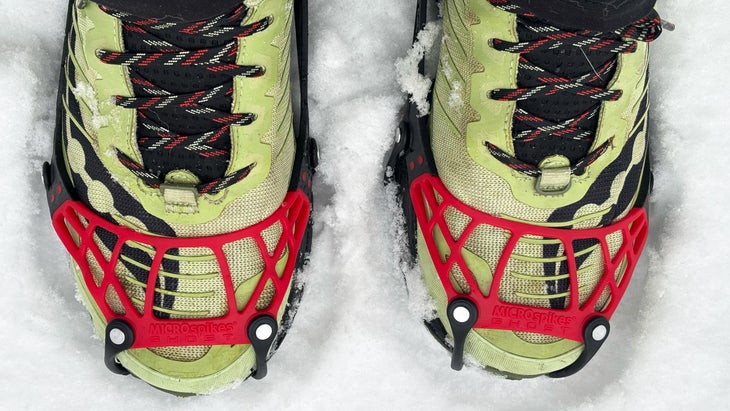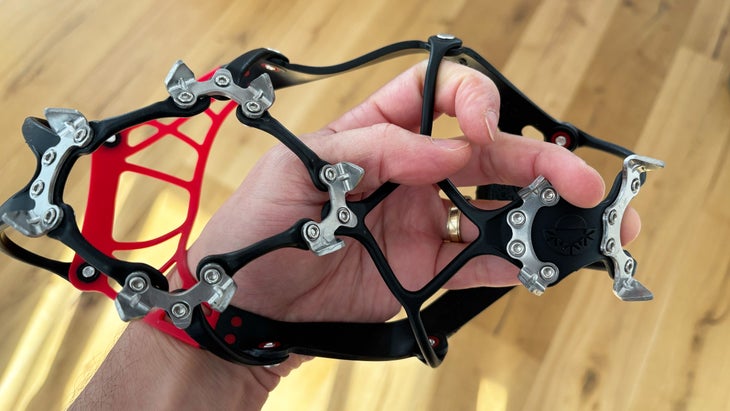Heading out the door? Read this article on the new Outside+ app available now on iOS devices for members! Download the app.
Traction devices are a point of contention for many thru-hikers. Many long trails in this country include stretches of hiking over ice, snow, and glacier depending on when you start and the direction you hike. Some hikers opt out of carrying them altogether for weight-savings. Some send them to resupply points, hoping that their timing will line up. Others won’t leave the trailhead without them. Kahtoola’s Microspikes Ghost, available September 2025, will make the decision easier: Weighing in at a scant 6.8 ounces per pair (3.4 ounces each), it will be the lightest full-foot traction device on the market.
If you buy through our links, we may earn an affiliate commission. This supports our mission to get more people active and outside. Learn more.
Kahtoola, one of the original makers of traction devices for non-glaciated travel (they literally copyrighted the name “MICROspike” back in 2007,) hasn’t seen a ton of variation in its offerings since we gave its flagship product a coveted Editor’s Choice award back in 2012. The Microspike is a wildly popular piece of kit for all types of hikers because it’s simple, relatively cheap, and works well in a variety of winter conditions. The basic design includes a simple thermoplastic elastomer band, thermoplastic polyurethane eyelets, and a set of stainless steel chains and 12 spikes that sit underfoot.
For ultralight hikers, however, Kahtoola’s standard microspikes are heavy. On my scale, a set in size medium weighs 12 ounces a pair—nearly as much as a Therm-A-Rest XLite NXT sleeping pad. It’s not a bear canister, but you don’t want to be carrying one unnecessarily.

Rethinking the Microspike
In short, Kahtoola managed to cut its weight almost in half by swapping the standard stainless steel chain design for a hardened TPU webbing. A hybrid elastomer harness—the stretchy band on top—is similar to what you’d find on a standard pair of Microspikes, just a bit thinner. A slightly less stretchy elastomer webbing cage sits over the toe.
The Ghost gets is flexibility (critical to keep the harness from twisting and turning while you walk and prevent snow buildup) from stainless steel rivets that allow each section of TPU and stainless steel spike cluster to pivot underfoot.
The most surprising thing about these Microspikes are its teeth. Because of all the weight-savings on the harness, Kahtoola was able to keep its standard spike layout: eight under the toe and forefoot, four under the heel. These spikes are robust, too: at roughly 10 millimeters, they’re just short of standard Kahtoola Microspikes, which measure nearly 12 millimeters with my ruler. That means you’ll still get significant traction on snow-covered ice and messy trails.
Overall, durability seems excellent. Over dozens of miles on ice-packed dirt roads in central Vermont and sloppy, boulder-strewn trails, like The Burrow’s Trail up Camel’s Hump, we never found any stretching, snapping, or popping of rivets.
Downsides
There’s a ton to love about the Ghost, but plenty of room for improvement, too. Our chief complaint? You can feel the pressure points where the rivets sit under the forefoot. We didn’t notice any marking or biting into our hiking boots’ outsole thanks to the smooth stainless steel rivet tops, but you can definitely feel the contact points going over hard, packed ice. Over dozens of miles, this could lead to soreness or even bruising.
The front elastomer cage, too, feels like a possible weak point. While we never noticed any deformation in day-to-day use, you can stretch the cage, a bit like a stiff rubber band, if you really pull on it. Time will tell if it ends up being an issue.
Finally, the Ghost will cost you. At $100, it’s on the high end for a traction device. With the exception of Black Diamond’s offerings, it’s the most expensive option on the market. On the plus side, you’ll get a four-year warranty, which is really what you’re paying for with any reputable traction device brand. You can find serviceable Microspike knock-offs for $25 on Amazon, but good luck submitting a warranty.

The Competition
While this is Kahtoola’s first foray into ultralight traction, there’s an entire market for welterweight traction devices geared towards ultralighters and trail runners. The Snowline Chainsen brand, under climbing/mountaineering company, CAMP, makes the Ghost’s closest competitor: the Trail Light, which comes in at 7.1 ounces per pair. It has a standard microspike design, but scaled down, roughly 5-millimeter teeth—not particularly useful in sloppy conditions. Black Diamond’s Distance Spike traction device weighs 8 ounces per pair and has nearly 8 millimeter teeth. Better than Chainsen’s Trail Light, but not as robust as the Ghost. Lastly, for the true gram-counters, there’s Vargo’s V3 Pocket Cleat: three titanium octagons that strap under your boot or trail runner. It’s extremely light at 4.8 ounces per pair, with significant 13 millimeter teeth, but you lose sure-footedness and precision owing to its simple design. It’s good in a pinch, but not great for sketchy sections or comfortable for long distances.
Should You Buy the Ghost for Your Next Thru-Hike?
Kahtoola’s upcoming Microspikes Ghost sets a new bar for full-foot traction devices in terms of weight and bite. There will still be folks for whom a 6.8 ounce weight penalty is unacceptable, but for most thru-hikers and folks who regularly hike in icy climates, it’s a no-brainer insurance policy. For extended stretches of trail, we still find the traditional chain and stainless steel plate design more comfortable underfoot. Stay tuned for our report after a full season of winter testing.
